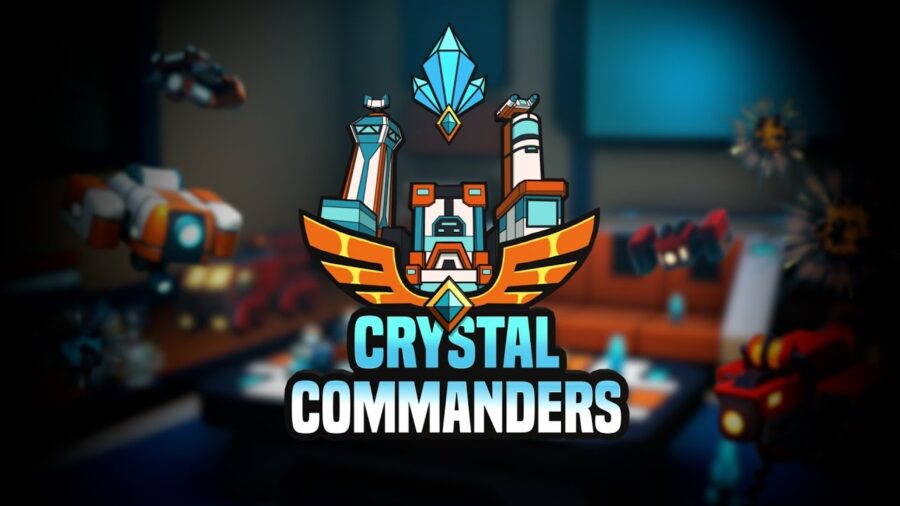
TL;DR for Crystal Commanders
(played on a Meta Quest 3 128 GB model)
| Pros | Cons |
| + Classic RTS mechanics, imaginatively streamlined into VR | – No multiplayer matchmaking system |
| + Tight 1v1 multiplayer combat | – Dead-easy and poorly written campaign |
| – Shallow sound design |
INTRODUCTION
RTS: Real-time Strategy.
This niche genre is a long-time love affair of mine, and indie team DB Creations honours the staples of that genre in their new mixed reality (MR) title, Crystal Commanders.
Crystal Commanders does its best to bring genuine RTS thrills to the Meta Quest, succeeding and innovating in important ways, but falling short in others.
Its most novel feature is its use of MR to turn your home into the game’s map, taking advantage of furniture and room layout to render elevation and terrain.
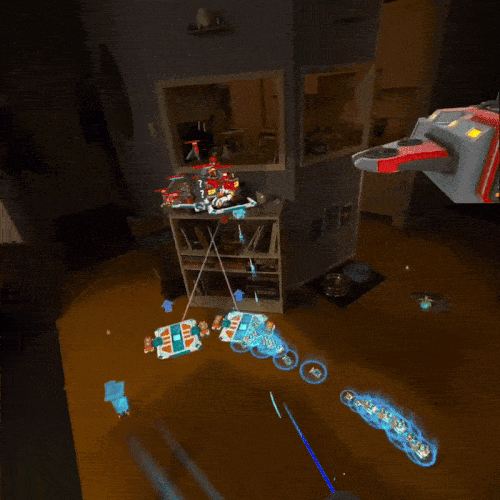
Now I’ve got a lot to say, so for those of you short on time I’m going to generously give you the shortest version of my review right now before firing into the details of what this title does, and its place in RTS history more broadly as I see it:
If you casually want to live out the child-like fantasy of playing with a live, futuristic army in your living room; buy this game immediately.
If you want the adrenaline rush of out-strategizing a cunning tactical mind in real-time, then you’d better be ready to convince a friend to buy it as well—or to make some friends over on the game’s Discord—because there is currently no multiplayer matchmaking system.
And if you want a challenging single-player campaign with lots of tactical depth and replayability… well… better just to skip this one.
I think that this title is better understood within the context of its genre—one sometimes called “dead” by people who don’t know what words mean—than understood in a vacuum.
But if you just want to hear more about my time with the game without all that highfalutin “context” and “profound insight into where the artform is going” then spit out that crayon and skip to the section titled GAMEPLAY AND PERFORMANCE!
CONTEXT & BACKGROUND
The RTS genre is—and perhaps always will be—niche.
Its complex and fundamentally unfamiliar skill set makes for a high barrier to competitive competence.
Getting good enough to win multiplayer matches in RTS just isn’t as straightforward as it is in, say, a shooter for example.
Now let’s be clear: I’m talking about the competitive skill floor here, not the ceiling.
The ceiling for any multiplayer game is always relative to its best players.
Being the best means beating the best means no game is much harder than any other at the very top level of competition.
Catch my drift?
Again, the competitive floor is high in RTS because its mechanics are both complex and fundamentally unfamiliar.
To oversimplify that idea:
Shooters let you move like people move.
You control your character’s movement with your left hand, and you shoot with your right.
This also extends (with some modification) to the ambiguous “action RPG” or just “action” games more generally.
And platformers? You move with your left hand and jump with your right.
Fighters? Move with your left; attack with your right.
Racers? Move left, yada yada.
You get it.
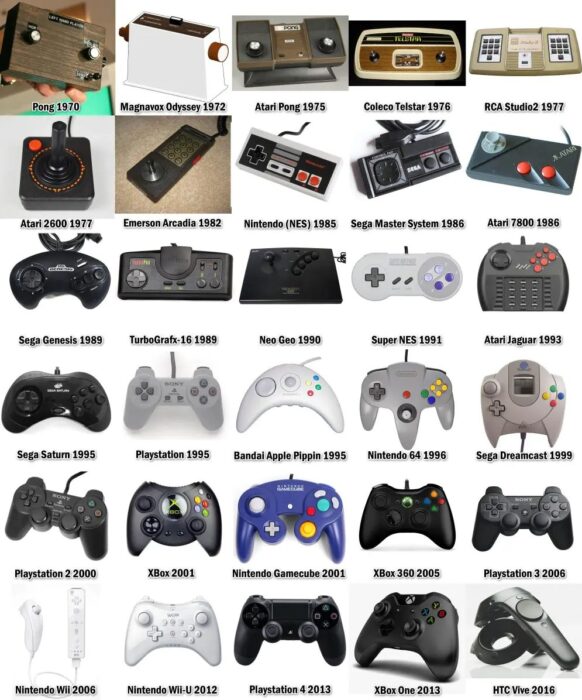
Most games in most genres have adopted some version of this basic left-hand-moves while right-hand-acts framework.
In my cursory research on the topic, it seems that this de facto control scheme baseline might be such a standard ‘given’ that it’s actually managed to go unnamed.
So I’m now coining them as LIMRIIC controls (Left-Input Movement, Right-Input Interaction/Camera).
If it turns out I’m wrong and a shorthand already exists then please either correct me, or—if it’s less catchy than LIMRIIC—just start saying LIMRIIC instead, you in-the-know gamer, you.
Anyway, as LIMRIIC controls became the default over decades, they’ve inversely created an invisible obstacle for players trying to learn any other scheme.

You see, the consequence of LIMRIIC dominance is that most games have become easier to just pick up and play, taking sometimes only moments for players to adjust.
But those games that—for one reason or another—don’t use LIMRIIC risk feeling a bit alien (unless they meet certain conditions).
You might be thinking of some exceptions to the LIMRIIC scheme, and I’d reckon they fall into one of two camps:
Either 1.) those games with no time-based demand—no exigent requirement to act in real-time—or 2.) those games with alternate controls simple enough not to freeze up your hands in somatic confusion.
So grand strategy games, turn-based RPGs, and visual novels are examples of camp one.
While rhythm games, some puzzlers, and a few fringe stragglers like pinball sims are examples of camp two.
Still with me?
All this high-minded design talk is to say that real-time strategy has been fundamentally relegated to a niche status because it defies LIMRIIC controls while being both 1. real-time and 2. mechanically complex (I mean it’s right there in the name).
As such, what often ends up happening in RTS games is that the player-base bifurcates hard into two camps. Let’s call them “casuals” and “sweats”.
Casuals learn the controls well enough to beat the AI and play through the campaign.
Sweats actually integrate the entirely different control scheme of the RTS into their muscle memory such that they can keep up on-ladder.
Now the truth here is that the real work of graduating from casual status to the lower end of sweaty probably takes about an hour.
You learn why a mouse and hotkeys make more sense for the genre than LIMRIIC, what those most important hotkeys do for your game, and then you hop into a practice match or two to get some reps in.
But sweats love their gamer cred.
So they pretend that it’s actually much harder than that; that they’re so elite for playing RTS on-ladder, thus perpetuating the various myths about how you need triple-digit APM and giga-brained Tsun Tsu tactics to actually play with the big dogs.
Then potential newcomers get intimidated and leave, and casuals never step out of their army-men sandbox AI skirmishes.

And while—in the grand scheme of things—one hour is not very long, you can see why it feels like a real impediment for new players who have been unconsciously conditioned to learn most other games’ controls in only moments.
So what’s the point of all this academic opining about genre and design in what is ostensibly a game review?
Well, if unintuitive controls really are the great-big problem for RTS, then bringing the genre to VR might just be the solution.
VR is still a fresh gaming medium. Developers innovate at an absurd rate.
I’m tempted to say that of the games I’ve reviewed here on Auganix, more of them had some level of genuine innovation than didn’t. And that’s just not something that can be said about console or PC gaming anymore.
As such, VR gamers are naturally more open to big changes in how a game controls. And this is helped along by the diegetic nature of the platform.
So I posit:
Just as rhythm games like Guitar Hero can use simplicity to sidestep LIMRIIC controls while maintaining a real-time fast pace, RTS games like Crystal Commanders can use the immersion of VR to do the same.
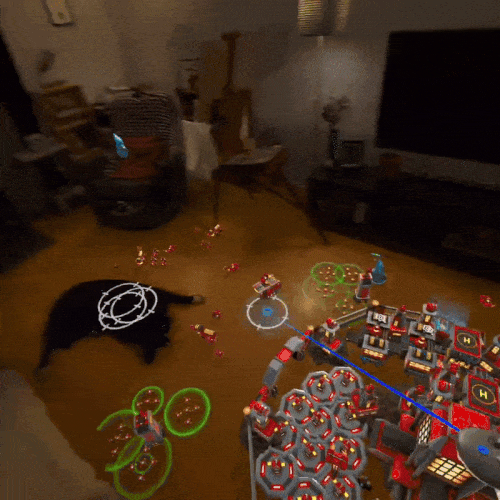
Where PC RTS requires you to constantly context-switch from, let’s say, the on-screen battle for a mid-map control point, to the cavalry raiding your base, to your idle workers who just finished extracting that whole deposit of resources—either by nudging the edge of your screen to pan around, or, more commonly, by clicking the minimap on your HUD—VR RTS lets you see everything at once (fog of war permitting).
You’re not trying to scope a large and dynamic 3D map from a fixed isometric camera angle on a 2D monitor.
You’re right there, seeing the battlefield from all angles with your God-given peripheral vision and neck muscles; no hotkeys required.
Micro-managing units?
Just physically look closer at your army and select the units you want.
Manipulating your laser-guided cursor around obstacles in three dimensions is much easier than trying to shift-click individual units in a cluster from a fixed isometric angle.
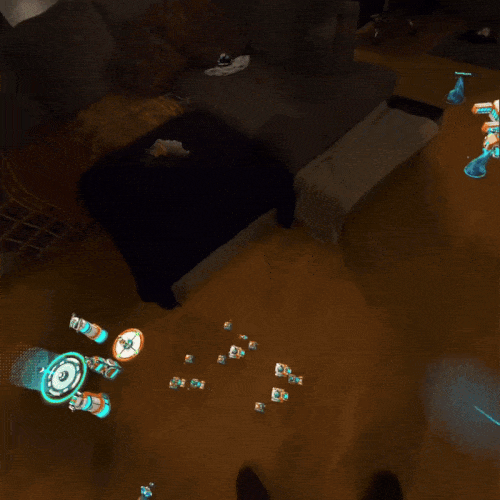
Keep your pants on, sweats.
I know that you’re antsy about console ports and how they’re always worse because they sacrifice precision for streamlined controls.
You end up with the same fixed isometric perspective as on PC, but with fewer buttons and a thumbstick cursor instead of a mouse.
It’s an insurmountable handicap to skill expression. True. On console.
And while I can’t say for sure that the two controllers and expanded perspective of VR RTS will ever completely make up for the modular complexity of a mouse and keyboard, it does clearly have some distinct advantages.
Lo, Crystal Commanders has convinced me that a new, parallel branch of RTS development may be on the horizon; one that works specifically to the platform’s strengths.
I’ve focused thus far on the broad potential for the RTS genre in VR because I reckon that Crystal Commanders might just be the truest-to-form of the lot yet.
GAMEPLAY & PERFORMANCE
Crystal Commanders includes many staple mechanics of the genre that have been left conspicuously absent in the handful of other VR RTS titles available:
- Multiple game modes—standard domination, point capture, and target elimination—help replayability.
- Fog of war and line of sight need to be managed with units and buildings, making early and consistent scouting important.
- Unit and building variety is excellent, featuring towers, walls, eco drop-off sites, and production buildings for both ground and aerial military units.
- The unit pathing is well executed and visible as a dotted line to its destination upon movement-command input.
- Resource deposit locations are randomly generated across the MR map.
- MOBA/Tower Defense-style lanes are rejected in favour of totally open terrain, blocked only by whatever big pieces of furniture might present a natural obstacle or elevation-
Oh. Hold up.
I just realized that that means you can make your own maps by moving around boxes and furniture and stuff!
And the fact that you can play multiplayer locally to set up forts with the homies?
Man, this game is just like bringing toys to life.
How rad. I hope they expand on that.
Further into what makes the game unique, you select multiple units via a free area selection mechanic (kinda like the lasso tool in Photoshop) as opposed to the genre-standard draggable rectangle.
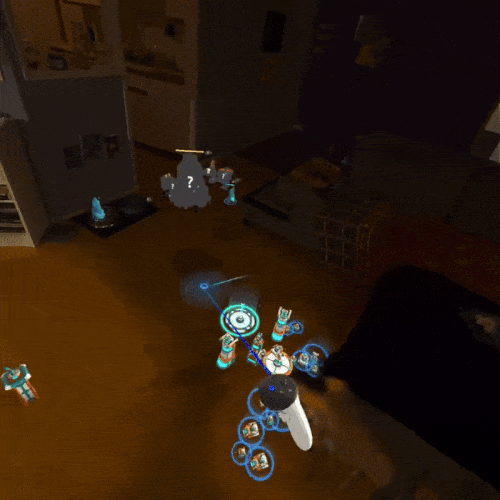
This is just one more way that the game takes advantage of its medium.
If you’re hanging out in three dimensions (as I often am) it makes more sense to have that sort of free-form malleability to pick your units instead of dragging a rectangle like you do on a screen.
And while I think its impressive suite of mechanics and novel MR staging are fundamental and massive points in the right direction, Crystal Commanders launches with plenty of faults and places to grow.
For example, a few of the bugs I came across:
- Units right in the middle of my selection often wouldn’t register, so I had to manually add them one by one into my selection group.
- Sometimes units would get permanently stuck in place.
- More than once in the game’s relatively short campaign—during missions where I was meant to build up defenses to survive enemy assaults—the enemy just couldn’t find me. And after waiting for several minutes I was greeted with a “Mission Accomplished” screen; better than being forced into a loss, but still not great.
There are more. None game-breaking but all annoying; distracting.
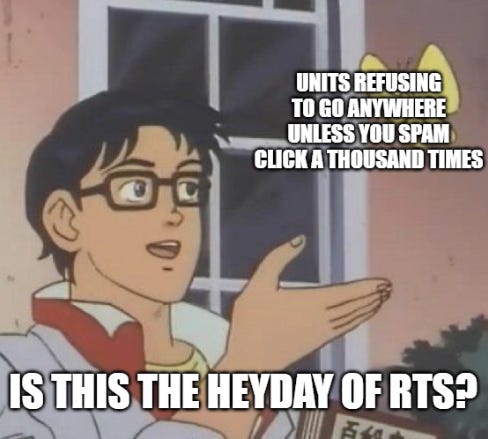
And this seems to be the state of modern gaming. It’s expected that new games will be released a bit buggy and—like in the case of Crystal Commanders—sometimes missing features.
Simplifying the RTS interface to suit it for VR is expected and largely well executed by DB Creations.
But I think there are moments where that simplification goes a little too far.
On instinct, I found myself pressing the left trigger to mimic the Shift key, trying to queue commands to my units. Alas, no dice.
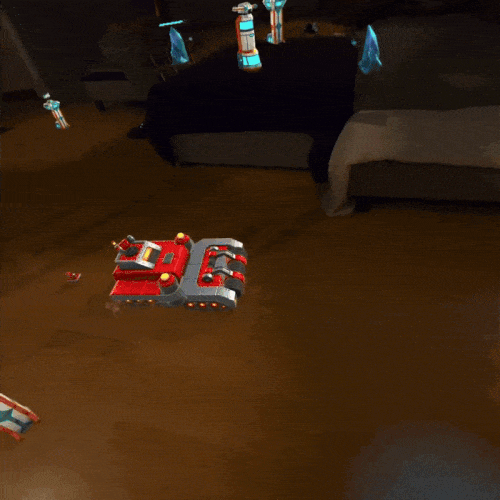
I’m told that the devs plan to add command queueing and control groups to the game.
But on-release they’re not there, even though some buttons remain yet unmapped on the Quest controller.
Hopefully they’ll be adding a harder difficulty for the campaign as well.
As it stands—at least for a sweat like me—there is just absolutely no challenge to speak of.
If I hadn’t hit up the game’s Discord to try out some multiplayer, this game would probably rank about two points lower.
That’s because the campaign—in addition to being way too easy—is set in a totally uninspired story with flat, nothing characters who speak (well voice-acted) flat, nothing dialogue.
The “story” is about good army guys and bad army guys fighting over blah blah blah and has nothing to do with being Toy Story-esque little dudes in a world of giants.
As such, the MR component of the game is totally divorced from its vapid—thankfully skippable—story.
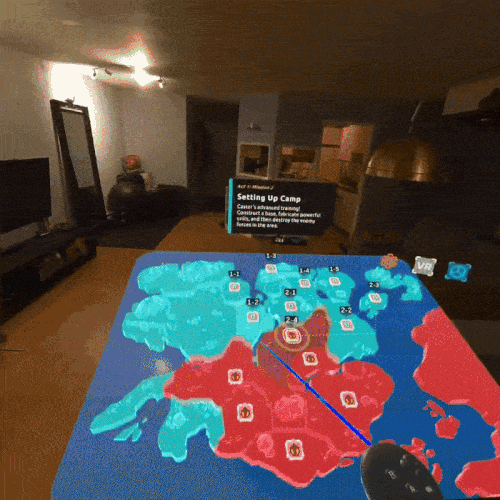
For those of you who have read my previous reviews, you know that I deeply value coherent design philosophies, especially when the gameplay, aesthetics, and story find ways to rhyme with each other.
And on that front, this game ain’t it.
I’ve got some more thoughts, but this is quickly becoming Auganix’s longest-ever game review so let’s wrap things up.
VERDICT
A bold step forward for the genre, Crystal Commanders proves that you can bring classic RTS gameplay into VR—with all its base-building, fog of war, and random map seeds intact—iterating on what makes it great in ways uniquely complimentary to the medium.
This core premise—paired with the promise of future updates from the development team—means that I’ll have my eye on where this title goes in the future.
However, the game is marred by its flat single player campaign, shallow sound design, and lack of multiplayer matchmaking. It’s a cool set of RTS mechanics—thoughtfully implemented—with very few places to see them expressed.
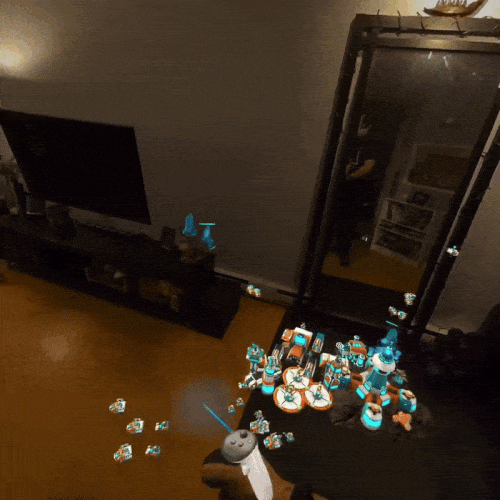
Crystal Commanders is an excellent choice for baby’s-first-RTS or for fans of the genre who don’t mind taking the extra step to seek out multiplayer.
And thanks to that very solid multiplayer, Crystal Commanders ekes out a 7/10.
Hyper-Objective Omniscient Evaluation Yardstick
Scores are out of 10, where 10 is a masterpiece, 1 is unplayable, and 5 is just average.
Gameplay has a heavier weighting toward the overall score.
Gameplay – 8
Graphics – 7
Immersion – 4
Replayability – 7
Performance – 7
Sound – 5
Image / video credit: Auganix / DB Creations
About the author
Kierkegaard once said that the artist is like one stuck inside Phalaris' brass bull, which burned up its victims and—due to the formation of its apertures—made beautiful music from their anguish.
The critic, he said, is just like the artist except he doesn't have the anguish in his heart nor the music on his lips.
A lifelong gamer based out of Vancouver, Pelé disagrees with Kierkegaard.
